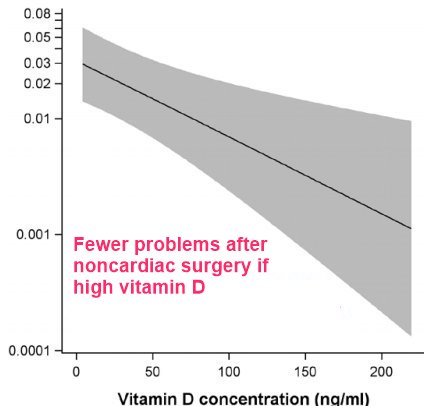Little risk of infection after surgery if have more than 50 ng of vitamin D - 2014
Association Between Preoperative 25-Hydroxyvitamin D Level and Hospital-Acquired Infections Following Roux-en-Y Gastric Bypass Surgery
JAMA Surg. 2014;149(2):112-118. doi:10.1001/jamasurg.2013.3176
Sadeq A. Quraishi, MD, MHA; Edward A. Bittner, MD, PhD; Livnat Blum, BA;Mathew M. Hutter, MD, MPH; CarlosA. CamargoJr, MD, DrPH

📄 Download the PDF from VitaminDWiki
IMPORTANCE Postoperative hospital-acquired infections (HAIs) may result from disruption of natural barrier sites. Recent studies have linked vitamin D status and barrier site integrity.
OBJECTIVE To investigate the association between preoperative vitamin D status and the risk for HAIs.
DESIGN, SETTING, AND PARTICIPANTS A retrospective analysis was performed using propensity score methods to construct a matched-pairs cohort to reduce baseline differences between patients with 25-hydroxyvitamin D (25[OH]D) levels less than 30 ng/mLvs 30 ng/mL or greater. Multivariable logistic regression analysis was then performed to examine the association between 25(OH)D levels and HAIs while adjusting for additional perioperative factors. Locally weighted scatterplot smoothing was used to depict the relationship between increasing 25(OH)D levels and the risk for HAIs. This study was conducted in a single, teaching hospital in Boston, Massachusetts, and involved 770 gastric bypass surgery patients between January 1, 2007, and December 31,2011.
EXPOSURES Preoperative 25(OH)D levels.
MAIN OUTCOMES AND MEASURES Association between preoperative 25(OH)D levels and the riskfor postoperative HAIs.
RESULTS The riskfor HAIswas3-fold greater (adjusted odds ratio, 3.05; 95% CI, 1.34-6.94) in patients with 25(OH)D levels less than 30 ng/mL vs 30 ng/mL or greater. Further adjustment for additional perioperative factors did not materially change this association. Locally weighted scatterplot smoothing analysis depicted a near inverse linear relationship between vitamin D status and the risk for HAIs for 25(OH)D levels around 30 ng/mL.
CONCLUSIONS AND RELEVANCE In our patient cohort, a significant inverse association was observed between preoperative 25(OH)D levels and the risk for HAIs. These results suggest that preoperative 25(OH)D levels may be a modifiable risk factor for postoperative nosocomial infections. Prospective studies must determine whether there is a potential benefit to preoperative optimization of vitamin D status.
Study was cited by 67 publications as of Nov 2022
- The Association of Serum Vitamin D Concentration with Serious Complications After Noncardiac Surgery- 2014 📄 PDF

20 X less likely if very high vitamin D
